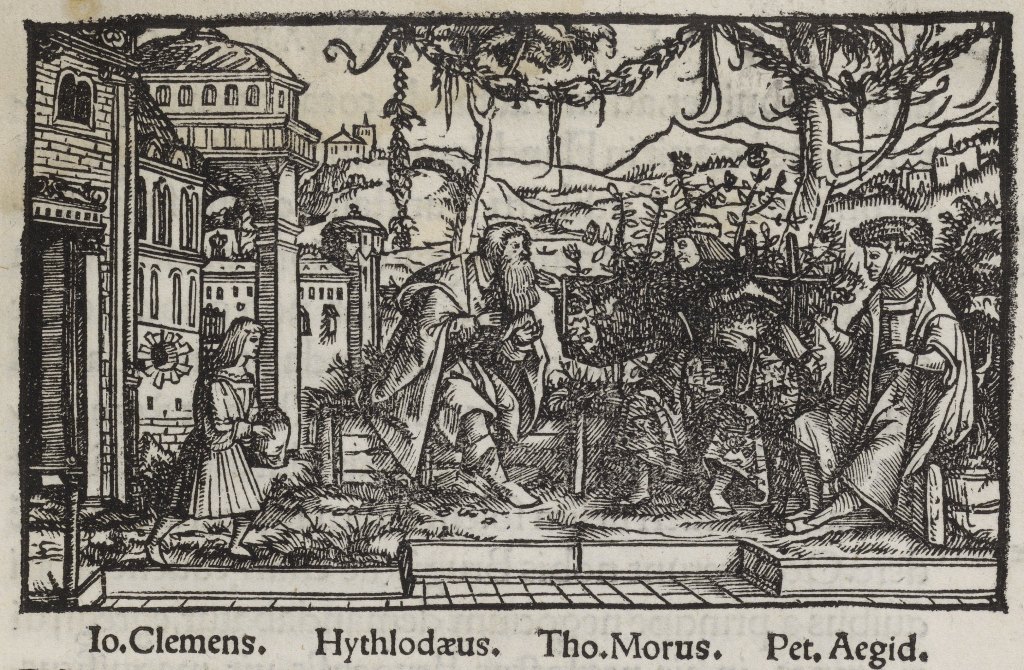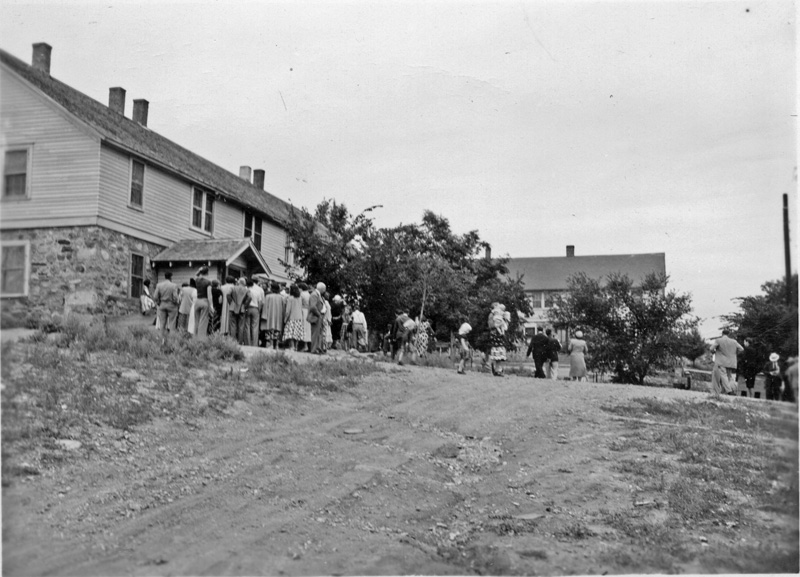Martin Lutz
Thomas More’s “little, true book, not less beneficial than enjoyable, about how things should be in a state and about the new island Utopia” – more commonly known as just Utopia – imagined a society based on common property, with full equality, no poverty, and an abundance of daily necessities for all. First published in 1516, this fictitious tale outlined a seemingly perfect commonwealth, providing a stark contrast to contemporary economic inequality and social misery.1

How could Utopia’s citizens achieve such a phenomenal economic performance leading to seemingly universal welfare? There was no idleness, for one, as everyone was expected to work and contribute to society’s well-being. As the character Raphael Hythloday explains to his puzzled listeners, “if they all were put to work—and useful work at that—you can easily see how little time would be enough and more than enough time to produce all the goods required for human needs and conveniences.”2 Moreover, Utopians did not pursue their own interest in their economic activity but tried to serve the general need. But it was especially the principle of common property that allowed the island to establish such a beneficial commonwealth. As Hythloday summarizes:
For elsewhere they always talk about the public good but they are concerned with their own private welfare; here [in Utopia], where there is no private property, everyone works seriously for the public good. And for good reason in both places, for elsewhere is there anyone who does not know that unless he looks out for his own personal interest he will die of hunger, no matter how flourishing the commonwealth may be; therefore necessity causes him to think he should watch out for his own good, not that of others, that is, of the people. On the other hand, here, where everything belongs to everyone, no one doubts that (as long as care is taken that the public storehouses are full) nothing whatever will be lacking to anyone for his own use. For the distribution of goods is not niggardly; no one is a pauper or a beggar there, and though no one has anything, all are rich.3
How utopian is such an economic world in the context of modern capitalism, an age usually associated with individual profit maximization, competitive markets, self-interest and greed? In other words, is it at all possible for the infamous homo economicus to break out from the real world to create something even vaguely similar to Thomas More’s Utopia?
A rare glimpse into the diary of a German traveler to the American and Canadian West in the years 1930-31 offers such an alternative perspective. It was in the midst of the Great Depression that hit Germany even harder then North America, inflicting political turmoil and contributing to the rise of the Nazi Party. The diary’s first entry dates from July 18, 1930, the day when German Reichspräsident Paul von Hindenburg dissolved the Weimar Republic’s last parliamentary government. The following election campaign was marked by ever increasing unemployment rates, strong antisemitic and anti-democratic sentiment from the extremist left and right. In the September election, the Nazi party won a landslide victory, a key milestone on Hitler’s ascent to political power that he finally achieved in January 1933.
The lone German traveler, who sympathized with Christian socialism and who was a staunch pacifist, thus had much to ponder on his journey. With his home country in turmoil and witnessing the Great Depression’s disastrous impact on America, his final destination must have appeared to him like a true Utopia. Nestled in the South Dakota plains, the visitor experienced the vision of a small-scale society based on communal property. There, all able-bodied members worked, including women and older children, contributing to the community’s overall welfare.4 In this setting, the communities produced sufficiently to sustain their membership, and it seemed to serve their commonwealth well. The traveler’s diary does not report a single issue that plighted Depression-era America: neither starvation, homelessness, unemployment, nor social deprivation.
It does probably not to come to the surprise of this blog’s readers that the communities in question were the Hutterite Bruderhöfe, scattered across the Northern Plains in the United States and Canada. The traveler was Eberhard Arnold, who had experimented with communal living in the 1920s and founded the Rhön Bruderhof in 1926. His trip to America served the purpose of connecting the newly founded community in Germany to the historical Hutterite church. Being well versed in Anabaptist history and belief, Arnold enthusiastically wrote that “[u]p till today the complete communism in production and consumption of every single Bruderhof […] and also the absolute unity of faith of all 35 Bruderhöfe is as good as completely unshaken; one can almost say is preserved absolutely pure.”5 This “purity” of the Bruderhof community was firmly based on Anabaptist-Hutterite religious principles, in particular the central tenant to forgo individual property and to “have all things common” (Acts 4:32).
The Hutterite communal economics not only provides a seemingly stark contrast to its capitalist surroundings; it also exemplifies how moral values decisively shape economic thinking, institutions and practice. This is the core of the current scholarly debate on moral economy, an interdisciplinary field of research that has grown from humble beginnings to prominence in the last decades.6
In The Moral Economists,7 intellectual historian Tim Rogan places the debate’s origin to T.H. Tawney, a British economic historian who published the influential book Religion and the Rise of Capitalism in 1926. Tawney found much at fault with modern capitalism, and it is in the context of his fundamental moral critique that he referred to Thomas More’s Utopia. Tawney was no mere academic confined to his ivory tower. He engaged in workers’ education, sympathized with Christian socialism and was politically active. Likely Tawney never learned about the Hutterites; otherwise he surely would have been keenly interested in this form of Christian communism.

Other academics, however, took note of the Hutterite communal economy. One was historian Victor Peters who in the 1965 book All Things Common provided one of the first systematic analyses of the Hutterite economic way of life in the context of modern American capitalism. It is no coincidence that the book’s opener immediately refers to Thomas More’s Utopia, for Peters considered the Hutterite Bruderhof as
literally utopian, for it was Thomas More who wrote: “For what can be more rich than to live joyfully and tranquilly without any worry, not fearful for his own livelihood, nor vexed and troubled with his wife’s importunate complaints, not dreading poverty to his sons, nor anxious about his daughter’s dowry? But instead to be secure about the livelihood and happiness of their wives, children, grandchildren, and their posterity which they handsomely assume will be a long time.”8
And yet, not all seems to have been as ideal and idealistic in practice. Twenty-five years before Peters’ scholarly account, Eberhard Arnold admiringly wrote about the impressive agricultural operations he observed, including a “very large mill,” a “gigantic thresher” and “the most modern motors.” While this sophisticated (and likely quite expensive) modern equipment at first glance appeared to be highly beneficial for improving efficiency in production, a somewhat puzzled Arnold also noted a counter perspective. It was voiced by an elder at Rockport Bruderhof who did not praise the progress, but rather was worried about decay, lamenting “the no longer Hutterian school, the economic rationalization of the Bruderhöfe, the influence of the world and diminishing unity in the style of life and the waning influence of elders.”9
From Eberhard Arnold’s perspective, trying to find an escape from the troubled circumstances in Germany, his puzzlement seems understandable. At the same time, the Rockport elder’s concern is highly plausible from a more distant analytical viewpoint. By 1930, American Hutterites were far from isolated, even if their remote settlement location would appear to be. The Bruderhöfe were instead tightly connected with their environment, particularly in economic terms. Hutterites produced for the market and were in turn susceptible to volatile prices, took out loans, bought machinery, and in many other ways relied on exchange with the outside world.
It thus should not surprise us that Hutterites were confronted with beliefs, ideologies, and rationales that competed with or were in direct opposition to their own Anabaptist beliefs. How should a Hutterite discern the logic of economic growth, profit-maximization, expansion, and efficiency gains in a competitive environment? How could Hutterite moral values be compatible with the requirements of modern capitalism? And how would this eventually shape the seeming “purity” of the Bruderhof community that Arnold so greatly admired in the following decades? Answers to these questions, I am convinced, will not only enhance our understanding of Hutterites in the context of the modern world. It would also offer a viable contribution to the much wider debate on the relationship between moral values and the economy.
1. It is important to note, however, that Utopia was not without flaws, at least from a 21st century perspective. These include the institution of slavery, as well as imperial wars of aggression against the island’s neighbors. Katherine Hill recently addressed More’s Utopia in a different context in her post on this blog: https://anabaptisthistorians.org/2020/12/21/utopian-imaginations/
2. Thomas More, Utopia, with the assistance of Jerry Harp, and Clarence Miller, Second edition (New Haven, Conn, London: Yale University Press, 2014), 63.
3. More, Utopia, 129–30.
4. Eberhard Arnold’s Diary, 1973, Hist Mss I-447, Box 20, Goshen Archive, 6.
5. Eberhard Arnold’s Diary, 170.
6. From the extensive current literature see for example: Ute Frevert, “Moral Economies, Present and Past: Social Practices and Intellectual Controversies,” in Moral Economies, ed. Ute Frevert et al., Geschichte und Gesellschaft Heft 026 (Göttingen: Vandenhoeck & Ruprecht, 2019); Norbert Götz, “’Moral Economy’: Its Conceptual History and Analytical Prospects,” Journal of Global Ethics 11, no. 2 (2015); Andrew Sayer, “Approaching Moral Economy,” in The Moralization of the Markets, ed. Nico Stehr, Christoph Henning and Bernd Weiler, first paperback printing (New Brunswick, NJ, London: Transaction Publishers, 2010).
7 Tim Rogan, The Moral Economists: R.H. Tawney, Karl Polanyi, E.P. Thompson, and the Critique of Capitalism (Princeton, NJ: Princeton University Press, 2018).
8 Victor Peters, All Things Common: The Hutterian Way of Life (Minneapolis: The University of Minnesota Press, 1965), 102–3 A few years before this book, Peters had already introduced this idea in an article to the Manitoba Pageant, 7 (1961), 1: http://www.mhs.mb.ca/docs/pageant/07/hutterites.shtml. A more recent contribution is by Thomas Nauerth in the Plough Quarterly magazine, published by Bruderhof’s Plough Publishing House, the https://www.plough.com/en/topics/justice/politics/finding-utopia.
9 Eberhard Arnold’s Diary, 170.
